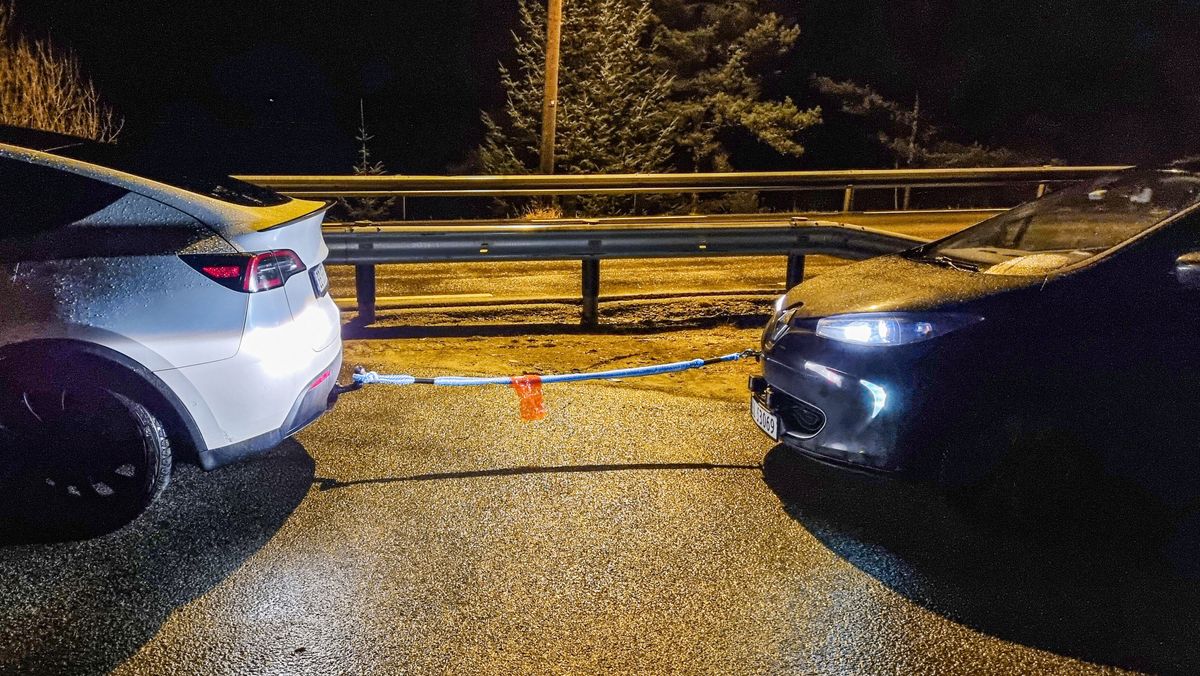Can you charge an electric car with a rope? Maybe a stupid question. Electric cars are charged by wires, not by ropes. But in principle this is possible.
When you’re standing there with a car that’s not charging and you don’t have enough range to drive to the workshop, the smartest thing is to call roadside assistance and move the car. But it would be an exorbitant cost, according to the Range Index, when the car only needs a weak mile to reach.
Such was the case for a TU journalist when suddenly year-old Renault Zoe began to have ground fault protection on the course used for charging. A workshop’s failed attempt to repair the car’s heat pump was the likely culprit. The car was otherwise fully drivable.
If we were at the top of a tall cliff, this wouldn’t have been such a big deal. So it’s just a matter of replenishing energy on a slope. In our case, we were standing at sea level. Then the question became: Isn’t it just pulling the car a distance and letting it regenerate?
We are not the first to ask the question and we are not the first to experience it. But this was a good occasion.
The plan was to drag Zoe a few kilometers with his Tesla Model Y and try to get some power into the battery. Just enough for us to get where we were going.
In principle, an electric motor is just a generator. When the car brakes, the motor converts kinetic energy into electricity that is sent back to the battery. When driving downhill, the motor generates electricity and charges the battery.
So, in practice, it is possible to do the same thing while drawing. In this sense, the tow rope turns into a charging cable. Call it V2V (vehicle-to-vehicle) if you like.
Do not do this
Before we continue: This should not be read as a recommendation. On the contrary, we must advise everyone not to attempt it.
First, it is practically difficult to get a reasonable distance from the vehicle in front. The Road Traffic Act does not say anything specific about the minimum distance between vehicles, other than that the distance must be so great that there is no risk of a collision if the driver brakes or stops.
The length of a normal tow rope is from 4 to 4.5 meters. If the police deem the distance too short for speeding, you risk confiscating your driver’s license. In other words, you must go slowly.
Two cars crawling at low speed can also be an obstacle in traffic. Therefore, towing is not something you should do over long distances, not while there is a lot of traffic on the road.
It can also be very expensive. The vehicle’s owner’s manual states that the vehicle must be left free if it must be towed. It is unlikely that a car’s power electronics could have been designed with vigorous regeneration in mind over a long period of time. Not to mention the stress this will put on the towing vehicle.
In short: don’t try this at home.

That’s how it went
Renault has been linked to Tesla. Then it was driven slowly and quietly at low speed for about six kilometers before we made a U-turn and backed up.
We kept control of how much the Renault regenerated and tried to stay around 20 kilowatts. We expected the car to start protesting along the way by giving us error messages or reducing regeneration due to heat generation. But Reno was happy and acted like she was coming down a long, long hill.
After the first stage, according to the vehicle information, we were able to generate 3.5 kWh. We got the same amount back. Thus, we replenished a total of 7 kWh in flight and increased the battery state of charge by 25 percent. That should indicate a consumption of -58.3 kWh per 100 kilometres.
However, a 25 percent battery capacity corresponds to around 5.5 kWh, since the car has an available battery capacity of approximately 22 kWh.
So obviously a significant part of the energy goes away along the way. So the real consumption is -45.8 kWh per 100 km.
On the other hand, a Tesla car consumed 14 kWh on the same trip. In terms of experience, the car’s consumption amounts to 1.8 kWh per 100 kilometres, which at this point should correspond to around 2.1 kWh. Therefore, charging Renault 5.5 kWh cost 12 kWh.
That is, the additional consumption is 100 kWh per 100 km.
About 75 percent efficiency
If we assume that the additional consumption of the tow truck is 12 kilowatt-hours, and 5.5 kilowatt-hours remain on the Renault battery, then 45 percent of the energy we used ends up as energy in the battery. In other words, not so much in terms of efficiency.
This could tell us something about regeneration efficiency, at least on this car model. Efficiency appears to be about 75 percent if we consider how much energy the car claims to have regenerated compared to how much energy we put back into the battery.
Thus, a relatively large amount of energy is lost in the form of heat generation. In this case, most of the heat generation is likely in the motor, the power electronics doing the current rectification and the battery getting hot.
This car model can be charged with 22 kW normal charging. With this high power, the charging cable gets noticeably hotter. So we can assume that the cables between the components also heat up during regeneration.
We also noticed that there was no significant increase in battery temperature. The temperature increased by about five degrees to nine degrees.
In principle, there should be no problem for the car to take its toll over a longer period of time. This model actually uses the motor’s windings to charge, and the power that’s being supplied takes the same path from the charging station to the battery. It can also charge up to 43 kW AC.
Not designed for this
So we weren’t particularly concerned that this would be too much of a burden. Other cars are often designed differently and may not be designed to absorb high energy over a long period of time.
An example of this is the Ford Mustang Mach-e. In the summer of 2021, several of these planes crashed in Geiranger. engine She reported six cases after cars slid down the slopes of the western countryside. Ford had to roll out a software update to fix the problem.
It is likely that something similar would have happened to other cars if you tried to tow them in this way. In the worst case, this can lead to damage that can be complicated in terms of warranty and complaints.

“Web specialist. Lifelong zombie maven. Coffee ninja. Hipster-friendly analyst.”




